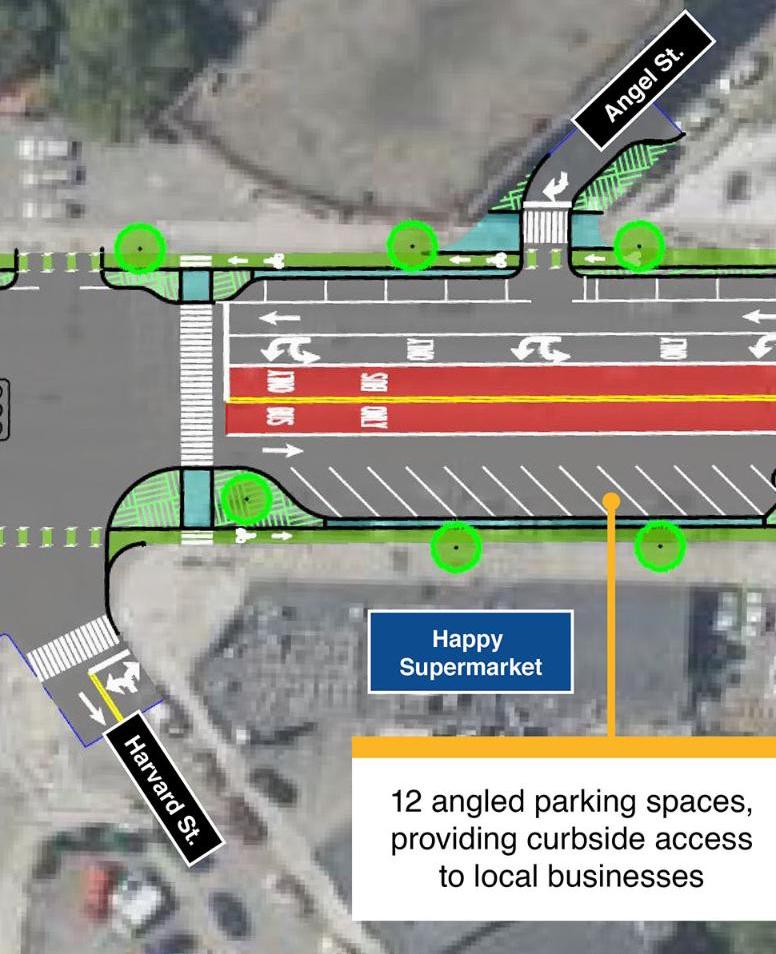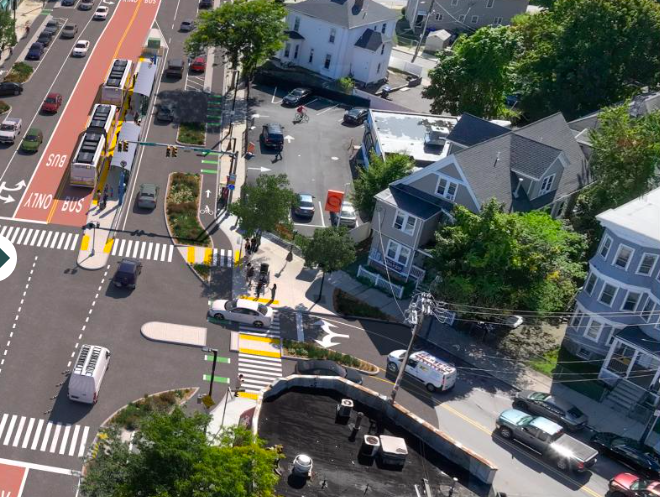November 20, 2024

Blue Hill Ave. near Morton Street. Seth Daniel photo
Neighbors and business leaders along the Blue Hill Avenue corridor got a look at the latest design elements of a state-and-city backed plan to redesign that key roadway during a workshop held at Mattapan’s Morningstar Baptist Church on Thurs., Nov. 7.
Construction work to add center bus lanes, new crosswalks, dedicated bike lanes, and other infrastructure features along the avenue between Grove Hall and Mattapan Square is not scheduled to begin until 2026. In the meantime, city and MBTA planners are engaging with the public in a series of workshops aimed at refining the project’s development.
“Right now, this is 15 percent of the complete design,” said Maya Mudgal, a transit planner with the Boston Transportation Department (BTD), who was on hand to talk with people who attended the event. The current plans, she said, were based on feedback received over the summer and “technical constraints we have for the project.”
Jascha Franklin-Hodge, the chief of streets for Boston, said more open houses are planned throughout the month of December. “What this is not is final engineering plans,” he said, stressing that this is the time to make sure “issues and concerns are addressed with the community.”
The plan shown that day includes 17 new signalized crosswalks, including one at Esmond Street that would also have a new dedicated left-turn lane for vehicles. Each crosswalk would be shorter, as most of the corridor is being whittled down to one vehicle lane with an occasional turning lane, aside from two lanes in the Morton Street and Mattapan Square areas.
The plans also showed between 9 and 11 platforms along the route— a figure that may change later based on public opinion. Platforms that are solidly in the plan include Fairway Street (Mattapan Square), Walk Hill Street, Wilcock Street/Ansel Road, Westview Street, Calder/Vesta, Ellington Street/Franklin Park, and Wayne/Supple. Platforms that are up for public debate include Woodhaven (Fairmount Line Station), Clarkwood Street, Goodale/Woolson Streets, Landor/Deering, and American Legion Highway.
There are three sections of the corridor — American Legion Highway, Woodhaven Street, and Goodale Road— at which the current design offers alternative configurations that are up for debate, according to planners. All three sections could see different solutions to route travel and turning lanes, among other variations.
Parking stood out as a major element of the still-evolving plan. A study conducted earlier this year showed that one in five spaces were available during peak times, with most vehicles – roughly two-thirds— parked in spaces for two hours or less. The same study found that 36 percent of vehicles parked along the corridor were not registered in Boston.
In Mattapan Square, where debate has bubbled whether or not to keep the current system of “angled” parking spaces along the avenue, the latest designs await what might be a compromise of sorts with angled parking kept on the eastern side of the street, and a new parallel parking configuration introduced on the western side, leaving two lanes of traffic for those backing out of the angled slots.
A major pinch point on the corridor is at the Harvard Street/Talbot Avenue intersection, where double- and triple-parking is common for those using the Happy Supermarket. The latest design includes angled parking to allow for more spaces and to alleviate the illegal parking. However, that leaves only travel lane, which many at the Nov. 7 meetings saw as problematic.

“I’m a ‘no’ on the angled parking there,” said state Rep. Russell Holmes. “We have to have more talks on that. That double-parking is not the culture we should encourage, but it is the one that’s there now. It seems we have to get serious about enforcement because it’s not there now.”
Others at the meeting also responded negatively to the idea. Mudgal said that’s why they are seeking input now.
“People had concerns about that,” she said. “That tells us that we need to look at that harder and maybe that solution proposed doesn’t work and we need to go back and think about that deeper.”
Holmes also said that while he supports the center-running bus concept, he has concerns about how it will affect east-to-west movements residents depend on, such as Abbot Street to American Legion Highway and Ellington Street to Franklin Park. While it’s treacherous going now, it appears it will be impossible in the new plans.
“The only way to get across there now is if someone decides to be nice to you. But what will people do in this plan to get across?” he asked.
While much of the avenue’s existing parking — about 90 percent— has been retained in the latest design, some merchants repeated a familiar refrain of opponents: That the plan prioritized the needs of the estimated 40,000 people that use the buses along the corridor over motorists.
Café Juice Up owner Denise O’Marde, who is supportive of some improvements in the plan, still hears resistance from many of her customers.
“The responses are mixed,” she said. “Surprisingly, there are a lot of area residents who have no idea that a re-design change is coming. The folks who are aware of the project are not supportive of the re-design. Usually mention is made of the re-design near Egleston [Square] on Columbus Avenue and the negative perception that work over there has created a mess.”
O’Marde is concerned about where her employees will park, as well as a place for her work van that is critical for deliveries to catered events – such as in the Longwood Medical Area or downtown.
Another concern raised was the lack of turnout for the Nov. 7 meeting. Despite the project team going door-to-door along the entire corridor and handing out fliers, only about 20 people came out.
“I think they definitely need higher turnout because they didn’t have a lot of businesses come and that means they need a different approach,” said Fatima Ali-Salaam, chair of the Greater Mattapan Neighborhood Council (GMNC), and an attendee on Nov. 7.
“It’s very clear they need to speak to a particular group and they need to speak directly to them because they control so many businesses on Blue Hill Avenue. If you’re not speaking to them, then that’s why there is no change…They have to know they are like any other business or resident on Blue Hill Avenue; we all have to respond.”
One of the groups noticeably absent from the process is the Fernandez family, who own numerous liquor stores, supermarkets, and a car wash along the corridor. Rep. Holmes said he planned to reach out and take walks with notable property owners.
“The car wash near Jubilee church – we have to walk together with them and not just flier them,” he said. “We have to walk through with them and make sure the plans don’t hurt their businesses.”
The remaining in-person open houses include Thurs., Nov. 21, at 5:30 p.m. in the Grove Hall Library at 41 Geneva Ave.; and Wed., Dec. 4, 5:30 p.m., in the Mattapan Teen Center at 10 Hazelton St.



